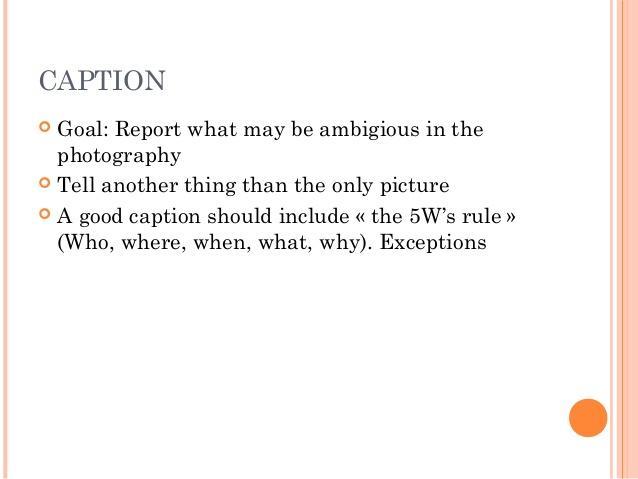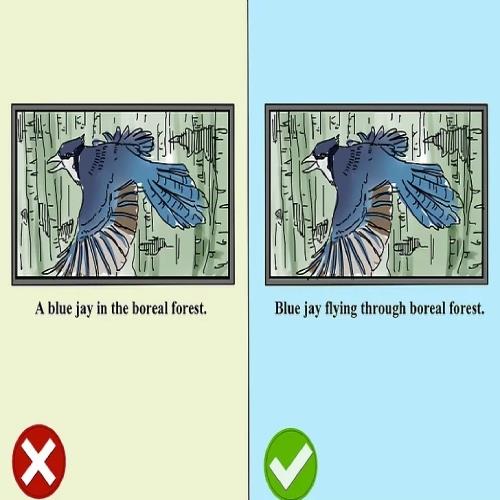In many publications, the most popular things readers look at are headlines, photos, and captions. Photos are worth a thousand words and can be used to summarize what the whole publication is about. Having a good and relevant cutline for the photo is important as it can determine whether readers will go ahead to read the article or not.
Despite being brief, Caption writing is not that easy. To help you write the perfect photo cutline in your next publication, here are a few tips that you can practice and use on the publication.
1. Reveal New Information

(https://www.slideshare.net/LucasFarcy/photojournalism-5965353)
When brainstorming for caption ideas, carefully analyze the photo to determine which information is obvious to those who see it. Once that has been determined, look for new information that you can use on the caption. Readers often want to get new information hence stating the obvious on the caption may not entice the reader to go through the article.
2. Name Famous People
If the photo has people who are well-known in society, make a point of naming famous people. If you are not sure of who they are, it is advisable not to mention any names to avoid legal issues later on. As you write the names, specify the direction you are starting with eg from left, Anna Beats.
3. Be Specific
While writing the caption, try to be as specific as possible. You can include the name of the event, where it happened and when it happened. Try to give readers all the important information they need in a brief statement.
4. Write Facts
You must be able to back up all the information you write with adequate proof. Avoid writing your opinion or information that has not been verified. Writing facts will help you build trust with your readers and you will avoid any misunderstandings in the long-run.
5. Include Credits
If you have used some quotes or citations from other people or pages, you should credit them on the caption to avoid plagiarism.
6. Conversational Tone
When your audience read your caption, they should feel like you are addressing them personally. Using a conversational manner is important in order to increase readership. If you are not sure how to write in a conversational manner and need some help, you can find more info to ensure your publication has everything done perfectly.
7. Be Brief
When writing a caption, you should first ask yourself, what is a caption? Once you understand what it is, you can determine what information to include. The caption should be very brief at the same time including all the relevant information. The perfect caption should be between one to three sentences. If the photo has a story about it in the publication, the caption should be very brief. If there is no story accompanying the photo, the caption can be a little longer.
8. Use Present Tense
The tense used in describing the photo is important. Always use the present tense for the caption. This is a requirement, especially for the first sentence. This is because you are capturing the moment the photo was taken hence you need to explain it as if it is presently happening.
9. Match the Caption Mood With the Image Mood
In photo writing, matching the caption mood with the image mood is extremely important to avoid offending your audience. If a photo has a serious and sensitive story behind it, the caption should reflect the same. Including humor may not be advisable and may deem you insensitive. When you find a photo you can include some humor, do so with caution.
10. Words and Terms to Avoid

(https://www.wikihow.com/Write-Good-Captions-in-Photojournalism)
Avoid starting your caption with words such as ‘a’, ‘an’, ‘the’. They will only take up space which you can use for more important information. Phrases such as ‘as shown above’, ‘is pictured’ and ‘is shown’ among others should be avoided as they are not relevant.
Conclusion
Captions are short but require effort to get them right. To create more engaging captions that increase readership, you need to include information that is not already revealed by the image. Having something new will spark your audience’s interest. Use present tense and match your tone to the tone of the photo. Ensure all the information included can be backed up and that you have credited all those who need to be credited. If you are unsure about some information, it is best not to include it to avoid legal issues.
Avoid using irrelevant words and phrases which take up space that could be used to include information useful to your audience.
BIO>
Jeff Blaylock is a professional writer and blogger. He has written numerous published articles for newspapers as well as magazines. Through the experience gained in his professional writing career, he has sharpened his skills and shares tips on how to be better in writing articles.









